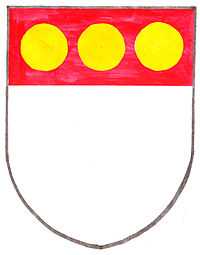Bezant


Bezant is a medieval term for a gold coin from the Byzantine Empire. The term is derived from the Greek name Βυζάντιον (Byzántion), the relatively minor city which in the 4th century was refounded as Nova Roma by the Roman Emperor Constantine the Great (thenceforth called Constantinople after his death) and became the capital of the Eastern Roman Empire. The Byzantine Empire was a major source of gold coins (solidi) since the time of Constantine.
History
Gold coins were not commonly minted in early medieval Western Europe (silver and bronze being the metals of choice for money). But they did circulate there in small numbers, originating from mints in the Eastern Mediterranean region. Typically gold coins were used when payments had some special ritual significance. In the West, the gold coins of Byzantine currency were highly prized. These gold coins were commonly called bezants, taken from the word Byzantium. The first "bezants" were the Byzantine solidi coins, minted at a constant weight and purity since the time of Constantine I (died 337) until the mid-11th century. Later the name was applied to the hyperpyra, which replaced the solidi in Constantinople in the late 11th century. The name hyperpyron was used by the late medieval Greeks, while the name bezant was used by the late medieval Italian merchants for the same coin. The Italians also used the name perpero or pipero for the same coin (an abridgement of the name hyperpyron).
Medievally, sometimes the term bezant referred to the gold dinar coins minted in the Islamic Caliphates, themselves modelled on the solidus. The term "bezant" was used in the late medieval Republic of Venice to refer to the Egyptian gold dinar. Marco Polo used the term bezant in the account of his travels to East Asia when describing the currencies of the Yuan Empire around the year 1300.[1] His descriptions were based on the conversion of 1 bezant = 20 groats = 133⅓ tornesel.[1] An Italian merchant's handbook dated about 1340, Pratica della mercatura by Pegolotti, used the term bisant for coins of North Africa (including Tunis and Tripoli), Cyprus, Armenia and Tabriz (in today's northwestern Iran), whereas it used the term perpero | pipero for the Byzantine bizant.[2]
Gold coinage began to be re-introduced to Western Europe in 1252 when the city of Florence began minting gold coins known as florins.
Bezants in heraldry


In heraldry, bezants are deemed a category of the roundel, of color or = "gold", that is to say they appear as gold discs in heraldic crests. Their name comes from the name of the coin. As with many charges in heraldry, the crusading era supplied many motifs, and it may have been whilst on crusade that many Western European knights first came into contact with Byzantine gold coins, and were perhaps struck with their fine quality and purity. During the Fourth Crusade the city of Constantinople, anciently Byzantium, was sacked by the Western Christian (mainly Venetian forces in 1204. During this sacking of the richest city of Europe, the gold bezant would have been very much in evidence, many of the knights no doubt having helped themselves very liberally to the booty. This event took place at the very dawn of the widespread adoption of armourials by the knightly class, and thus it may have been an obvious symbol for many returned crusaders to use in their new arms. A "field" or "bordure" semé with (strewn with, lit. "sown" with, as scattered seed) bezants is termed bezantée.
Notes
- ↑ 1.0 1.1 Yule, Henry; Cordier, Henri. The Travels of Marco Polo: The Complete Yule-Cordier Edition. Third edition (1903), revised and updated by Henri Cordier. Plain Label Books. p. 1226-27. (ISBN 1-60303-615-6)
- ↑ La Pratica della Mercatura, by Francesco Balducci Pegolotti, dated 1343, full text online in Italian at MedievalAcademy.org.
- ↑ Arms of Russell of Kingston Russell & Dyrham. Sir John Russell was a favoured courtier of King Henry III, granted by the King the barony of Newmarch c. 1216.